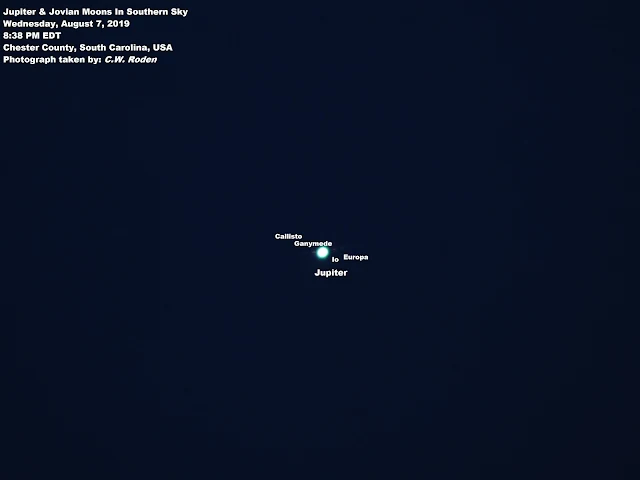Good evening fellow stargazers!
Well this evening I have a trifecta for y'all. Luna is in her First Quarter phase and visible in the early evening after sunset with the giant planet Jupiter and the 1st magnitude star, Antares.
I took three good shots, the first one a wide shot of the three heavenly bodies in the southern sky just after sunset.
Now here are some fun facts about the bright star, Antares.
Also called alpha Scorpii, Antares is a prominent star in the constellation Scorpius the Scorpion, which is visible in the southern night sky of most locations in the Northern Hemisphere. Antares itself is approximately 620 light years away from Earth. The bright red giant star is one of the brightest in the night sky and therefore one of the first stars visible after sunset after our neighboring Wanderers. Antares is a whopping 186 million miles wide, which compared to our solar system would encompass the orbit of the 4th planet, Mars, which rotates at around 141 million miles.
My second shot is a close up of Jupiter once again shows the four largest moons: Io, Ganymede, Callisto, and Europa, the famous Galilean moons in nearly a straight line -- almost like a ring around the planet. To give y'all some scale on the distance, the farthest of the moons, Callisto, orbits Jupiter at about 1,170,000 miles. Jupiter itself is about 87,000 miles wide at its equator, about 11.2 times the diameter of our Earth.
Well this evening I have a trifecta for y'all. Luna is in her First Quarter phase and visible in the early evening after sunset with the giant planet Jupiter and the 1st magnitude star, Antares.
I took three good shots, the first one a wide shot of the three heavenly bodies in the southern sky just after sunset.
Now here are some fun facts about the bright star, Antares.
Also called alpha Scorpii, Antares is a prominent star in the constellation Scorpius the Scorpion, which is visible in the southern night sky of most locations in the Northern Hemisphere. Antares itself is approximately 620 light years away from Earth. The bright red giant star is one of the brightest in the night sky and therefore one of the first stars visible after sunset after our neighboring Wanderers. Antares is a whopping 186 million miles wide, which compared to our solar system would encompass the orbit of the 4th planet, Mars, which rotates at around 141 million miles.
My second shot is a close up of Jupiter once again shows the four largest moons: Io, Ganymede, Callisto, and Europa, the famous Galilean moons in nearly a straight line -- almost like a ring around the planet. To give y'all some scale on the distance, the farthest of the moons, Callisto, orbits Jupiter at about 1,170,000 miles. Jupiter itself is about 87,000 miles wide at its equator, about 11.2 times the diameter of our Earth.
My last shot is a close up of our moon at First Quarter. You can see the craters in the southern hemisphere really well in the shot, as well as the Sea of Serenity right along the Earth's shadow on the Lunar surface. Just beneath it the Sea of Tranquility where the Apollo 11 lander set down 50 years ago last month. I think this one turned out beautifully.
Well folks, I hope that y'all enjoyed these photos and little fun facts about our planetary and celestial neighbors. I hope to bring y'all more night sky photography in the near future, summer cloud cover over our Southern skies permitting, of course.
Until next time, have a wonderful Dixie day and keep your eyes to the night skies, y'all!



No comments:
Post a Comment
Please Let Me Know What Y'all Think In The Comments Section.
All comments are moderated and can take up to 12 hours to be posted.
No blasphemy or anti-religious comments against anyone's faith are permitted on this site.